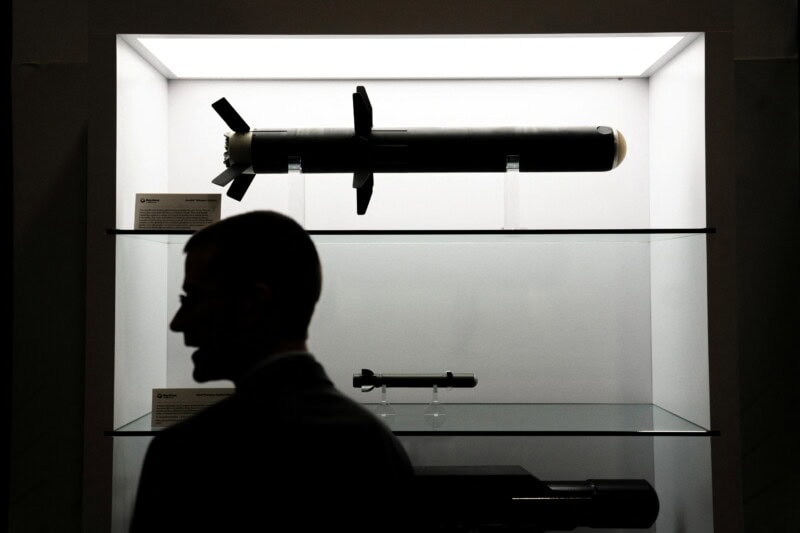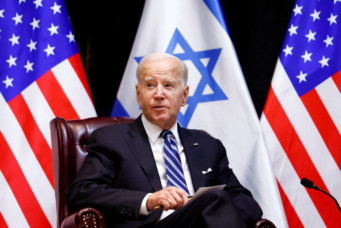Longer Sticks and Shorter Carrots: How the U.S. is Changing its Engagement in MENA
The United States’ approach to achieving international hegemony is shifting away from trade and investments back toward bombs and missiles

The Middle East is one of the few regions in the world that continues to retain persistent features of active colonialism well into the twenty-first century. The term in this context refers to the classical forms of military conquest, domination, occupation, and settlement that have been rendered illegal under the international order that emerged following the end of World War II in 1945. The region has also been one of the most frequently riddled by regional and extra-regional military conquest and intervention, notably by great powers. Needless to say, Israel’s settler colonialism has been a case in point, with major repercussions for the security and welfare of the region as a whole.
The U.S. invasion of Iraq in 2003 was one flagrant reenactment of a nineteenth century intervention whereby the empire comes sailing on its fleets to conquer a country thousands of miles away. It was the pinnacle of the U.S. attempt to use its military might to redraw the map of the region, and as a means for reasserting U.S. global dominance under the erstwhile neoconservative project of the American century. Obviously, that attempt failed miserably, ushering an extended period of reduced U.S. military involvement with the Middle East under former President Barack Obama (2008-2016) and President Donald Trump’s first term in office (2016-2020).
However, that reductive trend has been somewhat reversed starting from the redeployment of troops in Iraq and Syria as a part of the campaigns against the Islamic State organization in 2020. The United States has so far been keen on retaining its military bases in both countries in addition to those scattered across the Persian Gulf, and on using lethal force on several occasions against Iran-backed militias deemed threatening to U.S. personnel. The assassination of Qasem Soleimani in 2020, and the subsequent Iranian retaliation, served as another remarkable re-engagement through military means in the region. But MENA’s vulnerability to outside intervention has by no means been confined to Western powers: Russia’s military involvement in the Syrian civil war since 2015 can be easily fitted into the same colonial pattern.
I therefore argue that the Middle East’s historical susceptibility to outside military interventions has rendered it prime real estate for the assertion of global dominance through means of force. The region’s specialization in the production and exporting of fossil fuels after WWII and in the heydays of the Cold War provided the context to a long-term involvement of the United States replacing colonial traditional powers like Great Britain. This culminated in the American military intervention in the second Gulf war to liberate Kuwait from Iraqi invaders and hence maintaining a direct military presence in the region. By a similar token, Israel’s settler colonialism opened the way for long-term alliances first with old colonial powers like France in the 1950s and then with the United States in the wake of the 1967 war. Overall, the region has been but a condensed representation of wider global changes to America’s role in the world where military power is gradually overtaking economic mechanisms of influence such as aid, trade and investment.
Reflecting a Global Trend
The United States has become more rather than less militarily active in the Middle East over the past year-and-a-half, and particularly in the wake of the Israeli war on Gaza. To start with, the United States air bridge has been critical in sustaining Israel’s ability to continue and—later on—expand the war to Lebanon, Syria, Yemen, and Iran. Together with the United Kingdom, the United States has also been engaged against the Iran-based Houthis in Yemen. During the same period, the U.S. government actively dispatched air carriers, strategic bombers, and boosted its military presence in bases around the region in view of deterring Iran and supporting Israeli war activities throughout.
This increased U.S. military engagement in the Middle East has been part and parcel of a general global trend, as manifested in Eastern Europe, the South China Sea, and the Taiwan Strait. The United States has been compensating for its declining economic weight in trade, investment, and aid by increasingly leveraging its military superiority in different ways. The increasing involvement in the Middle East directly or through the limitless support to Israel under the Biden and the Trump administrations, is but one instance. Another is the increasing militarization of its technological superiority in previously civilian economic sectors like the semiconductors, artificial intelligence, and machine learning industries. But there are also Trump’s threats to withdraw military protection from Europe and Japan as a means to gain leverage on the U.S. historical allies, or even to directly pay to the U.S..
In a nutshell, U.S. influence in the world is undergoing a major shift, with the Middle East once again the focal point where such transformation is unfolding—thanks in part to the region’s history and present colonial and neocolonial intervention.
Whereas this militarization is meant to contain Russia and China in East Europe and East Asia, its approach to the Middle East has been more militarily proactive. Rather than just contain a powerful rival or enemy, the United States has since the Iraq debacle of 2003 been trying to reorganize its influence and control. The new American mantra is to provide less money and more bombs in support of Israel, deter Iran and its allies, and push for a security arrangement in the region revolving around an Israel-GCC. For the U.S., this alliance is militarily motivated and of little economic concern. The forging of this alliance—mainly focused on sharing military technology, which has been extensively put to use in the Gaza and Lebanon theater of operations —represents the global trend of the U.S. militarization of trade and investment. It also comes at the expense of the Palestinians in Gaza and the West Bank.
In addition to its geopolitical and international security goals, the U.S. role in the Middle East can also be understood through a political-economic lens. U.S. economic presence through trade and investment in the Middle East (as well as in many other parts of the Global South) has significantly declined in the past two decades, mostly ceding ground to China but also to other regional powers in MENA like Turkey and some of the GCC countries. Militarization has absorbed other areas like trade and investment (technology bans on China and onshoring of chips production) as well as aid (which has become largely reduced to military assistance to allies like Ukraine and Israel between 2022 and 2024).
Gone are the Days of “Nice” U.S. Hegemony
However, America’s hegemony over the post-WWII era was not just derived from its overwhelming military superiority but also established on firm institutional, economic, and ideological pillars that ran deep into post-war international security, economic recovery, and development dynamics and determinants. The United Nations and the Bretton Woods Institutions, as well as the dollar-based system it put in place, have all been creations of active U.S. diplomacy. Added to these were tens of regional and bilateral trade, investment, and aid arrangements with Western Europe, Latin America, and the newly independent nations of Africa and Asia. These all integrated the post-WWII world into an order of Washington’s making.
From a political economy perspective, the centrality of the U.S. economy to the world economic order can be little contested: The United States is a trade partner of most of the nations and regions of the world, the largest sender and recipient of foreign direct investment flows. It is also the country with the currency—the greenback—that has become how the bulk of global trade and investment transactions are conducted.
Hegemony is not all about consent and exchange, though, as liberals would like to believe. Conversely, it has always contained elements of coercion or even the outright use of violence in order to ensure compliance by the different parties to such a complex order. This mix follows not just philosopher Antonio Gramsci’s political theories but also Max Weber’s ideas about legitimation and domination, which would require the employment of coercion deemed legitimate in a manner complementary to consent.
My argument, which is in fact derived from well-established scholars and theorists in international political economy and international relations, is that the composition of this hegemony mix has undergone major changes in the past decade. The use of military force, or the credible threat of its deployment, has become much more central to the preservation of U.S. interests in multiple regions of the world. Moreover, economic exchange through trade and investment has been increasingly giving way to weaponization, securitization, and militarization. The U.S. trade war with China, and the increasing subjugation of economic exchange to logics of national security and geopolitical rivalry, are illustrations of this.
Economic ties with the Middle East are a case in point where U.S. relative weight as a trade partner, investor, and donor has visibly declined, especially if contrasted with that of China. In 2022, China stood as the biggest trade partner to the Middle East in both exports and imports.
Given the Middle East’s specialization in the production and exporting of oil and natural gas, China came to receive around a half of the region’s total energy exports. In the meantime, China was the source of sixty-seven percent of the region’s total imports of consumption and capital goods.
Conversely, the U.S. position as a major trade partner to the region came far behind the EU and India in both exports or imports. Part of the U.S. economic disengagement with the Middle East has been due to the decline in the former’s reliance on oil imports from the region over the past decades. However, it is also notable that the U.S. position as a whole has deteriorated when it came to imports.
The decline in U.S. relative weight as a trade partner has not been confined to the Middle East by any means but is a worldwide feature of its relations with Asia, South America, and Africa over the past three decades. In South America, once considered the U.S. backyard, China’s share in the continent’s total foreign trade grew from five percent in 2000 to a massive twenty-five percent in 2021. During the same interval, the U.S. share declined from twenty-five percent to fifteen percent. A similar trend could be noticed in Africa, with China climbing up to the position of the continent’s biggest trade partner since 2014, overtaking the United States as well as the former European colonial powers France and Britain.
More dramatic is the Association of Southeast Asian Nations’ (ASEAN) external trade, given the rising significance of East and Southeast Asia in global trade and industry over the past decades. ASEAN has some of the fastest growing economies in the world, notably the various generations of newly industrialized economies starting with Malaysia, Indonesia, and Thailand then passing to Vietnam and Cambodia in addition to one of the world’s financial centers: Singapore. In 2023, China was the bloc’s largest trade partner with a share of twenty percent of ASEAN’s total exports and thirty-one percent of its total imports. The United States’ shares were nineteen percent and nine percent, respectively.
Such regional trends rhyme well with China’s overall ascendency to becoming the world’s biggest exporting economy with a share of fourteen percent in 2022 versus 9.6 percent for the United States. It is, however, nonetheless worth noting that the United States retained its position as the world’s biggest importer (13.2 percent followed by China, 10.6 percent). Needless to say, this disparity between exports and imports further reinforced the United States’ huge chronic trade deficits with the world, especially with China.
Moreover, not only has the United States’ relative weight as a trade partner been on the decline globally and in the Middle East, but its position as a source of foreign direct investment inflows to the region has also diminished. Indeed, whereas the Chinese estimated the cumulative share of their investments in the Middle East in 2022 to be 273 billion U.S. dollars, those of U.S. investors stood at 80 billion in the same year.
In terms of foreign aid, the U.S. role as a development donor has also witnessed some noticeable decline, even before Trump’s serious attempts to dismantle the USAID altogether. To start with, the share of foreign aid to U.S. GDP has secularly declined from a massive five percent in 1945 to 0.19 percent in 2024. The same trend is more reinforced than ever with the Trump administration putting an abrupt end to basically all forms of USAID, with Israel standing out as the usual exception. This indicates less willingness to allocate resources in the form of aid, which has been part and parcel of the building up of the United States’ international hegemony since the end of WWII.
According to a U.S. Congress report in 2023, the MENA region has historically stood out as the single largest cumulative aid recipient between 1946 and 2020, with a total of 372.6 billion dollars. Israel received a massive thirty-eight percent of the total followed by Egypt and Jordan at twenty-one percent each. Notably, however, U.S. aid has become increasingly militarized in the past years with military aid overtaking economic and humanitarian aid. It says volumes that in 2023/2024 the two biggest U.S. aid recipients in the world were Ukraine and Israel, with military aid predominating in both cases.
The United States is not Going Anywhere, Anytime Soon
None of the above however indicate that the United States as a great power in both the world’s political economy and security would lose its relevance anytime soon. Two main points of strength stand out in this regard: military superiority and the centrality of the U.S. dollar in global trade and investment.
As for the U.S. dollar, its centrality as a de facto international currency is demonstrated in the fact that in 2022, fifty-nine percent of global foreign currency reserves were in dollars followed by twenty percent in Euros, ostensibly making it the de facto international currency. Sixty-four percent of world debt was denominated in dollars. Moreover, China, the United States’ closest economic rival, is very far from having its national currency replace the U.S. greenback. An international currency like the so-called BRICS currency is even more far-fetched.
However, there is something paradoxical about America’s financial domination, given its declining weight in international trade. The depth of U.S. financial markets owes a lot to the degree of financialization of the U.S. economy, a sign of weakness and volatility (as manifested in the 2008 meltdown that exposed the inherent instability in a financialized economy and had devastating impacts on the real economy) after decades of de-industrialization, which in turn has led to staggering income inequality and exacerbated the crisis of democratic institutions. In 2023, financial services constituted the single biggest sector in the U.S. economy. Estimated at 20.7 percent of U.S. GDP, it was followed by professional and business services (13 percent), government (11.4 percent) and finally manufacturing (10.3 percent). Conversely, in China in 2023, financial services stood for merely eight percent of GDP and came third following industry (31.7 percent) and wholesale and retail (9.8 percent).
As for military superiority, even in 2023, amid the war in Ukraine and the escalating tensions with China, total U.S. military expenditure was more than double of the expenditure by China and Russia combined. The United States is likely to remain ahead of its rivals for some time to. The strategy of investing in the United States’ military superiority has been an element of consensus so far within the circles of U.S. elites, be they liberal or conservative. It has historically overlapped with high-tech industries that would later on spill over into civilian uses, with the internet, space, and aviation standing as prominent examples. Interestingly enough, with the United States’ competitiveness eroding (mainly vis-à-vis China), the pendulum is moving in the opposite direction from the civilian to the military. Indeed, external trade, aid and investment have been the aspects getting securitized and militarized. This has been manifested with regards to microchips production, electric vehicles and the Tiktok ban where national security concerns gained primacy over the logic of free market exchange. In a similar vein, Trump declared a national emergency to impose universal tariffs against most of the world’s nations in April before having to suspend them for 90 days.
In short, the U.S. stick is getting longer, its carrots fewer and smaller. U.S. re-engagement with the Middle East reveals the transformation underway, whereby the U.S. role in the world will pass through more bombs, bombers, and air carriers rather than through trade and investment in peaceful endeavors.



